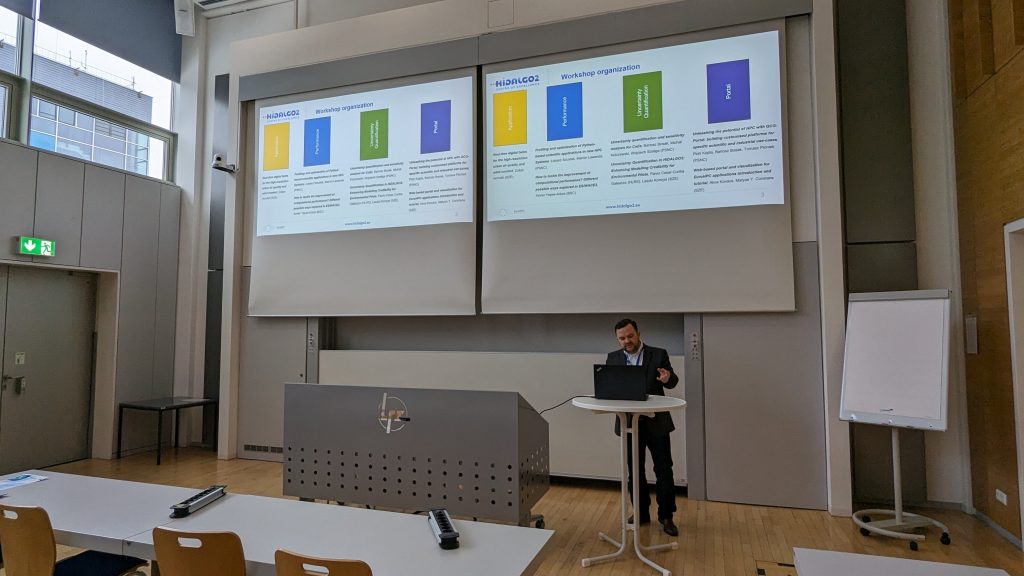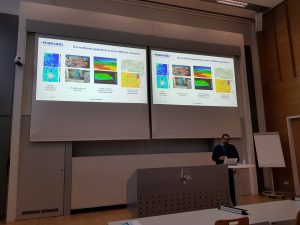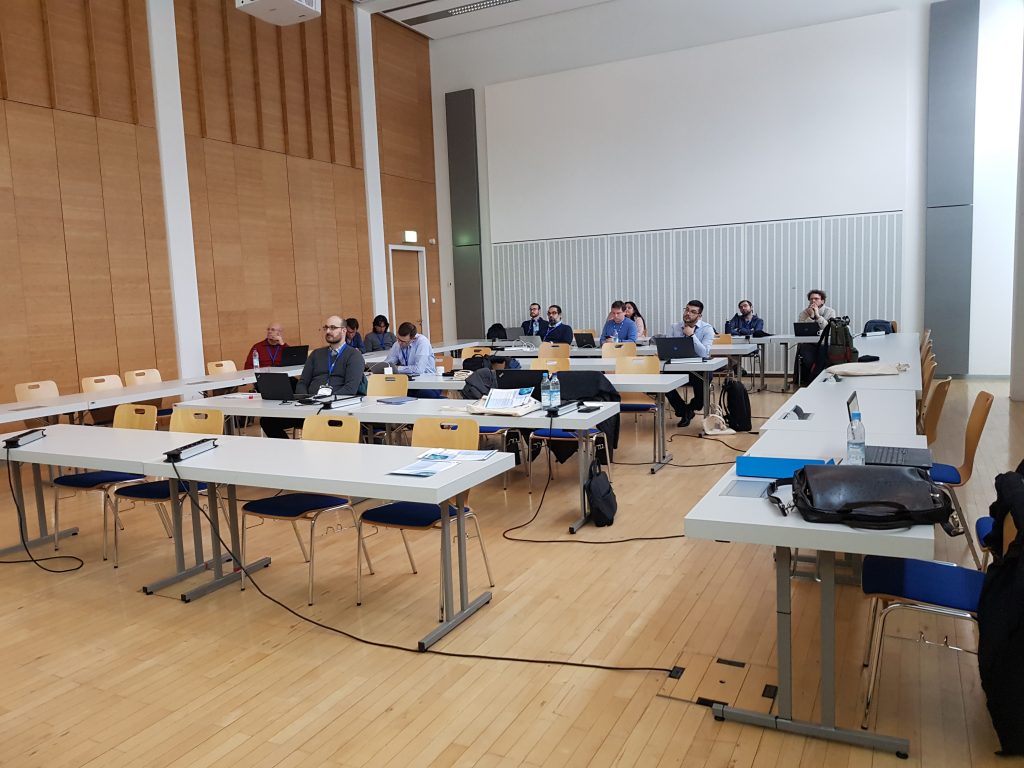The HiDALGO2 team is glad to have participated actively in the HiPEAC conference at the Science Congress Center last January 2024, in Munich, with the joint workshop “Towards reliable Digital Twin: advancing applications and tools’ capabilities for Global Challenges”. It was organised together with ESiWACE3, the Centre of Excellence in Simulation of Weather and Climate in Europe by our project coordinator Dr. Marcin Lawenda from Poznan Supercomputing and Networking Center (PSNC). HiPEAC is one of the most important European forums for experts in computer architecture, programming models, compilers, and operating systems for general-purpose, embedded, and cyber-physical systems.

During the session, participants had the opportunity to learn about various techniques used to build efficient simulation systems in the area of Global Systems Science. The training was divided into four thematic blocks and 7 sessions. The four blocks were digital twin applications, performance improvement, uncertainty estimation, and HPC access instrumentation.
The application section introduced the HiDALGO2 Urban Air Project, emphasising high-resolution urban wind comfort and air quality simulations. The performance section showcased improvements in Python-based applications on modern hardware and lossy compression tools for weather and climate data. The uncertainty quantification segment delved into how Centers of Excellence (CoEs) can apply uncertainty quantification and sensitivity analysis in their applications, while the final part focused on simplifying HPC cluster access through portal solutions, demonstrating customisation options for various applications via templates and custom views.
Presenters of the 7 different sessions of the workshop were: Łukasz Szustak, Bartosz Bosak, Michał Kulczewski, Wojciech Szeliga, Piotr Kopta, Tomasz Piontek (Poznan Supercomputing and Networking Center- PSNC), Flavio Cesar Cunha Galeazzo (HLRS – High-Performance Computing Center Stuttgart), Zoltán Horváth, Kornyei Laszlo, Ákos Kovács, and Mátyás Constans (Széchenyi István Egyetem-SZE) and Xavier Yepes-Arbós (Barcelona Supercomputing Center).


Namely, the team members from PSCN presented various thematic areas. Dr. Łukasz Szustak on co-design, Michał Kulczewski on uncertainty estimation, and Bartosz Bosak on the access to HPC systems.
More specifically, Łukasz Szustak presented the latest achievements in adapting parallel codes of large-scale applications to a wide range of modern high-power computer systems. The scope of work includes developing a methodology for adapting selected scientific applications to modern HPC systems, taking into account in particular a wide range of x86-64 and ARM processors. An important result of the tasks carried out is finding a compromise and synergy between parallel computations and the architecture of massively multi-core processors in order to enable performance calibration of the tested applications.
In the HiDALGO2 project, we develop applications not only from the usability side, increasing their efficiency and preparing them for launch on EXA-scale machines. We also pay attention to estimating the uncertainty of the input parameters and the model itself, thanks to which we increase the quality of the results and the reliability of the models. At the presentation by Michał Kulczewski, we encouraged users working on large-scale applications, to use mUQSA (multiscale uncertainty quantification and sensitivity analysis), a PSNC tool developed since the VECMA project, which allows for a virtually non-invasive estimation of the uncertainty of each large-scale application.
As part of the workshop presentation entitled “Unleashing the potential of HPC with QCG-Portal“, Bartosz Bosak presented unique functionalities and features of the set of QCG tools and services developed in the Large-Scale Applications and Services Department. Particular attention was paid to familiarising workshop participants with the possibilities offered by the QCG-Portal web solution in terms of building intuitive interfaces for running computational tasks on high-power computers, tailored to various needs. Moreover, the QCG-Pilot Job software was discussed, enabling the creation and effective execution of dynamic computational scenarios consisting of a large number of tasks in a cluster environment.
Matyas Constans from the SZE team introduced HiDALGO2’s approach by orchestration of HPC work in terms of configuration, deployment, execution, post-processing, and monitoring, which is inevitable in interfacing user interaction on such machines. Flavio Galeazo from the HRLS team focused on enhancing model credibility which is a fundamental challenge for simulation developers and can be done by the VVUQ approach of HiDALGO2’s tools utilisation.




Lastly, Xavier Yepes from our collaborator, Barcelona Supercomputing Center presented the way to leverage efficiency as weather & climate models are very demanding in terms of CPU performance. Read analytically about HiDALGO2 sessions at the HiPEAC Conference on our website here.
Other interesting sessions & projects

Except for HiDALGO2 sessions, other noteworthy presentations drew the attention of our partners who joined physically the event. Bartosz Bosak from PSCN shares with us the workshop “Classical HPC & QC: the way to foster integration” organised by E4 Computer Engineering S.p.A., which featured several noteworthy presentations. Discussions delved into the complexities of hybrid classical-quantum computing, exploring both challenges and opportunities. In addition, various strategies for integrating high-performance computing (HPC) with quantum computing (QC), tailored to specific use cases, were explored. Quantum computer vendors and HPC centers integrating quantum computers into their facilities took the opportunity to explain the features unique to each quantum technology. Also, Massimo Caccia, Professor at the Department of Science and Technology of Università degli Studi dell’Insubria gave an engaging presentation entitled “Random Power: in-silico quantum generation of bit streams with unpredictable state.” During his talk, he demonstrated how truly random infinite bit streams can be generated by relying only on the inherent properties of semiconductors.
For Zoltan Horvath from our partner SZE, the HiPEAC conference was useful for getting information on current coordination and support actions as well, besides the research and technology information from lectures. Namely, the DISCOVER-US project was introduced and discussed with the audience. DISCOVER-US is a pivotal CSA project to energise EU and USA collaborative research focusing on the new emerging framework for interdisciplinary coordination, the compute continuum. The compute continuum addresses all themes in distributed computing and swarm intelligence. It is worth mentioning that in September 2024 there will be a call for researcher exchange between the EU and the USA. All actions are planned with minimal bureaucracy and maximal efficiency. Also, the consultations we had with companies at various booths were very fruitful, in particular, the details on the academic program by the AMD company, as well as the opportunities for cooperation with the aerospace industry.
Flavio Cesar Cunha Galeazzo from our partner HRLS, found great interest in the session “EuroHPC Projects Shaping Europe’s HPC Landscape“, with productive results of the SuperTwin system, which creates a digital representation of an HPC system that can monitor, visualise and detect anomalies on it. The keynote held by Mitsuhisa Sato, deputy Director of RIKEN Center for Computational Science about the design of the supercomputer Fugaku was very insightful, including a deep discussion about the challenges faced by the future supercomputers.

This article was written collectively by all HiDALGO2 partners who joined physically the HiPEAC Conference and edited by Future Needs.
Follow HiDALGO2 on LinkedIn and X (Ex Twitter) to keep up to date with our activities, visit our dedicated webpage, and subscribe to our newsletter to learn more about other publications and presentations at conferences.









